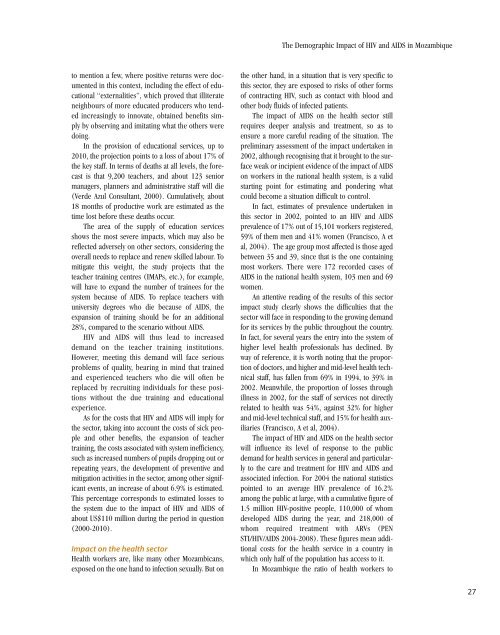English language version - Human Development Reports - United ...
English language version - Human Development Reports - United ...
English language version - Human Development Reports - United ...
- No tags were found...
Create successful ePaper yourself
Turn your PDF publications into a flip-book with our unique Google optimized e-Paper software.
The Demographic Impact of HIV and AIDS in Mozambiqueto mention a few, where positive returns were documentedin this context, including the effect of educational“externalities”, which proved that illiterateneighbours of more educated producers who tendedincreasingly to innovate, obtained benefits simplyby observing and imitating what the others weredoing.In the provision of educational services, up to2010, the projection points to a loss of about 17% ofthe key staff. In terms of deaths at all levels, the forecastis that 9,200 teachers, and about 123 seniormanagers, planners and administrative staff will die(Verde Azul Consultant, 2000). Cumulatively, about18 months of productive work are estimated as thetime lost before these deaths occur.The area of the supply of education servicesshows the most severe impacts, which may also bereflected adversely on other sectors, considering theoverall needs to replace and renew skilled labour. Tomitigate this weight, the study projects that theteacher training centres (IMAPs, etc.), for example,will have to expand the number of trainees for thesystem because of AIDS. To replace teachers withuniversity degrees who die because of AIDS, theexpansion of training should be for an additional28%, compared to the scenario without AIDS.HIV and AIDS will thus lead to increaseddemand on the teacher training institutions.However, meeting this demand will face seriousproblems of quality, bearing in mind that trainedand experienced teachers who die will often bereplaced by recruiting individuals for these positionswithout the due training and educationalexperience.As for the costs that HIV and AIDS will imply forthe sector, taking into account the costs of sick peopleand other benefits, the expansion of teachertraining, the costs associated with system inefficiency,such as increased numbers of pupils dropping out orrepeating years, the development of preventive andmitigation activities in the sector, among other significantevents, an increase of about 6.9% is estimated.This percentage corresponds to estimated losses tothe system due to the impact of HIV and AIDS ofabout US$110 million during the period in question(2000-2010).Impact on the health sectorHealth workers are, like many other Mozambicans,exposed on the one hand to infection sexually. But onthe other hand, in a situation that is very specific tothis sector, they are exposed to risks of other formsof contracting HIV, such as contact with blood andother body fluids of infected patients.The impact of AIDS on the health sector stillrequires deeper analysis and treatment, so as toensure a more careful reading of the situation. Thepreliminary assessment of the impact undertaken in2002, although recognising that it brought to the surfaceweak or incipient evidence of the impact of AIDSon workers in the national health system, is a validstarting point for estimating and pondering whatcould become a situation difficult to control.In fact, estimates of prevalence undertaken inthis sector in 2002, pointed to an HIV and AIDSprevalence of 17% out of 15,101 workers registered,59% of them men and 41% women (Francisco, A etal, 2004). The age group most affected is those agedbetween 35 and 39, since that is the one containingmost workers. There were 172 recorded cases ofAIDS in the national health system, 103 men and 69women.An attentive reading of the results of this sectorimpact study clearly shows the difficulties that thesector will face in responding to the growing demandfor its services by the public throughout the country.In fact, for several years the entry into the system ofhigher level health professionals has declined. Byway of reference, it is worth noting that the proportionof doctors, and higher and mid-level health technicalstaff, has fallen from 69% in 1994, to 39% in2002. Meanwhile, the proportion of losses throughillness in 2002, for the staff of services not directlyrelated to health was 54%, against 32% for higherand mid-level technical staff, and 15% for health auxiliaries(Francisco, A et al, 2004).The impact of HIV and AIDS on the health sectorwill influence its level of response to the publicdemand for health services in general and particularlyto the care and treatment for HIV and AIDS andassociated infection. For 2004 the national statisticspointed to an average HIV prevalence of 16.2%among the public at large, with a cumulative figure of1.5 million HIV-positive people, 110,000 of whomdeveloped AIDS during the year, and 218,000 ofwhom required treatment with ARVs (PENSTI/HIV/AIDS 2004-2008). These figures mean additionalcosts for the health service in a country inwhich only half of the population has access to it.In Mozambique the ratio of health workers to27
















